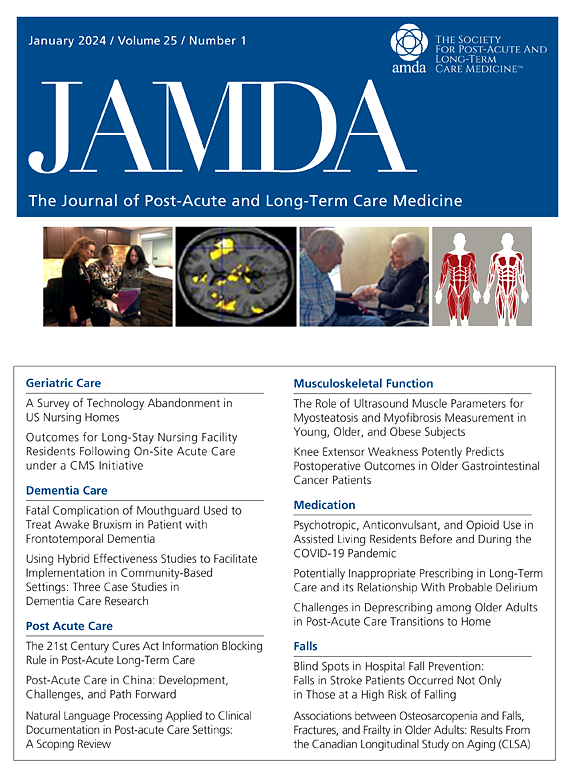家庭保健患者感染风险差异:基于区域剥夺指数的研究
IF 4.2
2区 医学
Q2 GERIATRICS & GERONTOLOGY
Journal of the American Medical Directors Association
Pub Date : 2025-02-18
DOI:10.1016/j.jamda.2024.105455
引用次数: 0
摘要
目的:探讨不同农村水平家庭卫生保健(HHC)患者邻里剥夺与感染相关住院的关系。设计:对2019年国家数据集进行回顾性观察分析,包括与2019年地区剥夺指数(ADI)数据和城乡连续代码(RUCCs)相关的医疗保险数据。环境和参与者:样本包括来自全国8135家HHC机构的3,656,810名HHC患者。患者以白人为主(77.6%),平均年龄80岁,以女性为主(61.7%)。样本包括24%的双重条件患者,以及生活在大城市(53.8%)、小城市(30.2%)、邻近农村(11.4%)和偏远农村地区(4.6%)的患者。方法:采用《国际疾病分类第十版》(ICD-10)编码对感染住院病例进行分类。邻里剥夺是通过2019年的ADI来衡量的。根据RUCC(大地铁、小地铁、邻近农村或偏远农村)对患者进行分层。在每个农村阶层中,构建了ADI四分位数,四分位数越高表明邻里剥夺程度越高。进行多变量logistic回归,对多水平变量进行调整。结果:随着社区剥夺的增加,双重资格的女性、黑人和西班牙裔患者的比例上升,而白人患者的比例下降,特别是在农村地区。ADI排名较高的农村地区显示出较低的质量指标和较少的卫生保健资源。在调整协变量后,较高的ADI四分位数与感染风险增加显著相关,但这仅在偏远农村地区观察到,而在城市地区没有观察到。结论和意义:研究结果强调了对偏远农村地区的重要政策和临床意义。决策者应增加对农村卫生基础设施的投资,加强远程保健,改善交通服务,并为卫生保健提供者在这些领域的实践提供奖励。在大都市地区,邻里剥夺与感染结果之间的不显著关联可能源于ADI对城市环境的有限敏感性,这突出了需要更细致的指标来更好地捕捉城市社会经济挑战。本文章由计算机程序翻译,如有差异,请以英文原文为准。
Disparities in Infection Risk Among Home Health Care Patients: A Study Using Area Deprivation Index
Objective
To examine the association between neighborhood deprivation and infection-related hospitalizations among home health care (HHC) patients across different rurality levels.
Design
Retrospective observation analysis of 2019 national data sets, including Medicare data linked to 2019 Area Deprivation Index (ADI) data and Rural-Urban Continuum Codes (RUCCs).
Setting and Participants
The sample includes 3,656,810 HHC patients from 8135 HHC agencies nationwide. Patients were predominantly White (77.6%), with an average age of 80 years, and mostly female (61.7%). The sample included 24% dual-eligible patients and those living in large metropolitan (53.8%), small metro (30.2%), rural adjacent (11.4%), and remote rural areas (4.6%).
Methods
Hospital admissions due to infection were identified through International Classification of Diseases, Tenth Revision (ICD-10), codes. Neighborhood deprivation was measured by the 2019 ADI. Patients were stratified by RUCC (large metro, small metro, rural adjacent, or remote rural). Within each rurality stratum, ADI quartiles were constructed, with higher quartiles indicating greater neighborhood deprivation. Multivariable logistic regression was conducted, adjusting for multiple-level variables.
Results
As neighborhood deprivation increased, there was a rise in the proportion of dual-eligible, female, Black, and Hispanic patients, whereas the proportion of White patients decreased, especially in rural areas. Rural areas with higher ADI rankings showed lower quality metrics and reduced health care resources. Higher ADI quartiles were significantly associated with increased infection risks after adjusting for covariates, but this was only observed in remote rural areas, not in urban areas.
Conclusions and Implications
The findings highlight significant policy and clinical implications for remote rural areas. Policymakers should increase investments in rural health infrastructure, enhance telehealth, improve transportation services, and offer incentives for health care providers to practice in these areas. The nonsignificant association between neighborhood deprivation and infection outcomes in metropolitan areas may stem from the ADI's limited sensitivity to urban contexts, highlighting the need for more nuanced indices that better capture urban socioeconomic challenges.
求助全文
通过发布文献求助,成功后即可免费获取论文全文。
去求助
来源期刊
CiteScore
11.10
自引率
6.60%
发文量
472
审稿时长
44 days
期刊介绍:
JAMDA, the official journal of AMDA - The Society for Post-Acute and Long-Term Care Medicine, is a leading peer-reviewed publication that offers practical information and research geared towards healthcare professionals in the post-acute and long-term care fields. It is also a valuable resource for policy-makers, organizational leaders, educators, and advocates.
The journal provides essential information for various healthcare professionals such as medical directors, attending physicians, nurses, consultant pharmacists, geriatric psychiatrists, nurse practitioners, physician assistants, physical and occupational therapists, social workers, and others involved in providing, overseeing, and promoting quality

 求助内容:
求助内容: 应助结果提醒方式:
应助结果提醒方式:


